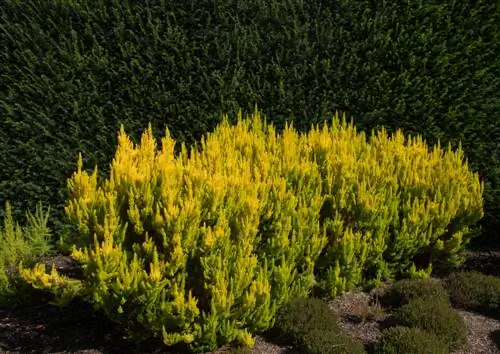- Author admin [email protected].
- Public 2023-12-16 16:46.
- Last modified 2025-01-23 11:21.
Privet is a shrub that requires almost no care. It is therefore ideal for people with little time and beginners. There are just a few points you should keep in mind if you want to care for privet as a hedge, potted plant or bonsai.

How do you care for a privet?
Privet care consists of correct watering (slightly moist, no waterlogging), fertilizing if necessary (slow-release fertilizer, compost, horn shavings, blue seed), regular cutting (especially for dense hedges) and winter care (hardy, water when there is no frost). Pests and diseases are rare and can usually be traced back to unfavorable locations.
How do you water privet properly?
The substrate should always be slightly moist. However, waterlogging should be avoided in any case. If the soil is dense, be sure to install drainage. A bottom layer of sand is also recommended when caring for the bucket.
When and how do you need to fertilize?
Fertilizing is generally not necessary if the substrate contains sufficient nutrients right from the start. If you want to fertilize to stimulate growth, fertilize with
- Long-term fertilizer
- Compost
- Horn shavings
- Bluegrain
Long-term fertilizer, compost and horn shavings are given in spring, blue grain must be given twice, at the end of April and beginning of August.
What should you pay attention to when cutting?
Cutting is the most important care measure for privet. Of course, you don't have to cut it at all if you don't want to. But if you want a dense hedge, you can't avoid frequent trimming.
Initially, privet is cut up to three times a year, in spring, August and autumn. Later, a double cut is enough. You can easily prune privet back to stock to rejuvenate it.
What diseases and pests can occur?
- Mildew
- Fungal infestation
- Root rot
- Privet aphid
- White Spider
- Bigmouth Weevil
Diseases occur very rarely and are usually triggered by locations that are too wet or dry.
Pest infestations occasionally occur. Most of the time, the privet can handle this on its own without any problems.
Why does privet lose its leaves?
If the privet loses its leaves in winter, this is a normal process because the shrub is not evergreen.
If it sheds its leaves in summer, diseases, pest infestation or drought can be responsible.
What does winter care look like?
All native privet species are hardy and only need some protection from too much winter sun. In dry winters, you should water on frost-free days.
Tip
If the privet becomes more and more bare over time, it may be because it is in the shade and does not get enough light. Choose a partially shaded or sunny location.






